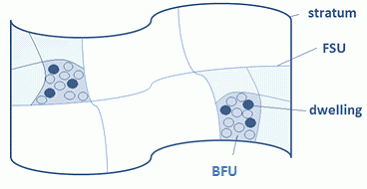A multiplicative decomposition model is applied in the seasonal adjustment of Labour Force Time Series, where the original time series (O) is considered as the product of the underlying trend (T), a systematic calendar related or seasonal component (S) and an irregular component (I). This can be expressed as O = T*S*I. The contributions of each of these behaviours varies from series to series, as well as throughout time for a given series, depending on the nature of the interactions of real world events and the data of interest.
The Labour Force Survey uses the concurrent seasonal adjustment method to derive seasonal factors. Concurrent seasonal adjustment uses data up to the current month to estimate seasonal factors for the current and all previous months. This process can result in revisions each month to estimates for earlier periods. However, in most instances, the only noticeable revisions will be to the seasonally adjusted estimates for the previous month and one year prior to the current month. From the March 2015 issue of this publication, the effects of supplementary surveys are removed prior to the estimation of seasonal factors for key Labour Force series from February 1978 onwards. While this methodology has addressed short term volatility in the seasonally adjusted series arising from changes to the timing and content of the supplementary survey program, in general prior corrections and resulting changed seasonal patterns can be identified and measured to a more reliable degree of certainty after three successive observations (in this case after three years). For further details refer to the October and December 2014 issues of this publication.
The revision properties of the seasonally adjusted and trend estimates can be improved by the use of Autoregressive Integrated Moving Average (ARIMA) modelling. ARIMA modelling relies on the characteristics of the series being analysed to project future period data. The projected values are temporary, intermediate values that are only used internally to improve the estimation of the seasonal factors. The projected data do not affect the original estimates and are discarded at the end of the seasonal adjustment process. The Labour Force Survey uses an ARIMA model for the majority of the individual time series. The ARIMA model is assessed as part of the annual reanalysis. For further details, see the feature article in the October 2004 issue of Australian Economic Indicators.
While seasonal adjustment is able to remove the effect of events which occur at the same time in the survey every year, there are some events, like holidays, which are not always at the same time in the survey cycle or which are not at the same time across Australia. The effects of these types of events on Labour Force Survey estimates cannot in all cases be removed, because the pattern of their effects cannot be determined. However, two events for which adjustment is made in the seasonally adjusted series are the January interview start date and the timing of Easter.
While seasonal factors for the complete time series are estimated each month, they are reviewed annually at a more detailed level to take into account each additional year's original data. This annual review does not normally result in significant changes to published estimates.
The smoothing of seasonally adjusted series to produce 'trend' series reduces the impact of the irregular component of the seasonally adjusted series. These trend estimates are derived by applying a 13-term Henderson-weighted moving average to all months except the last six. The last six monthly trend estimates are obtained by applying surrogates of the Henderson average to the seasonally adjusted series. Trend estimates are used to analyse the underlying behaviour of a series over time.
While this smoothing technique enables estimates to be produced for the latest month, it does result in revisions in addition to those caused by the revision of seasonally adjusted estimates. Generally, revisions due to the use of surrogates of the Henderson average become smaller, and after three months have a negligible impact on the series.
For further information, see A Guide to Interpreting Time Series - Monitoring Trends.
